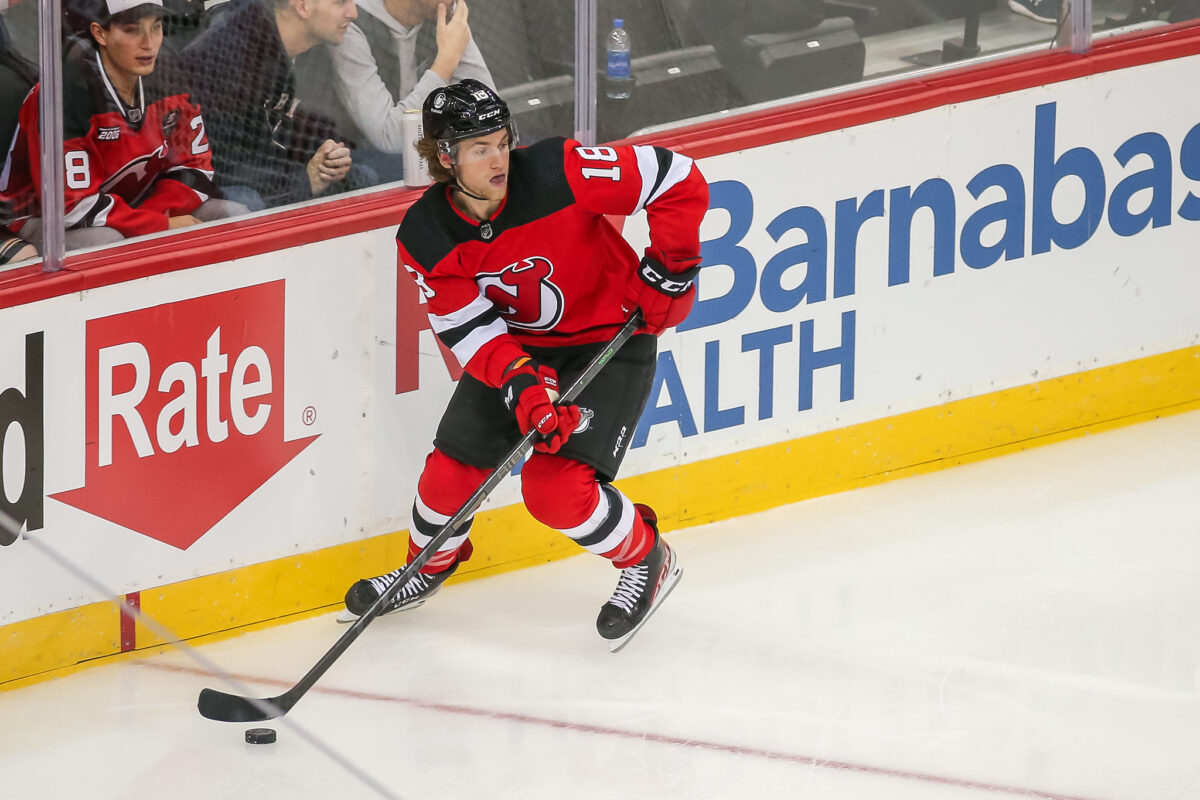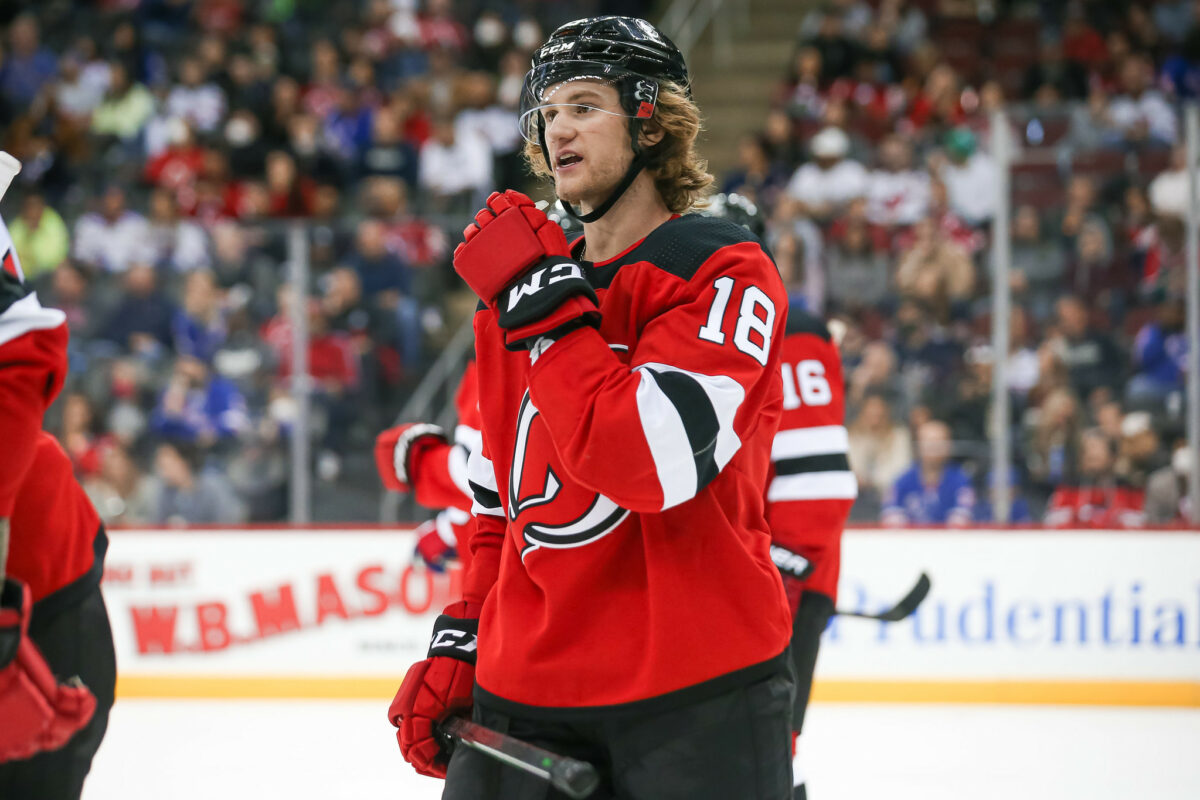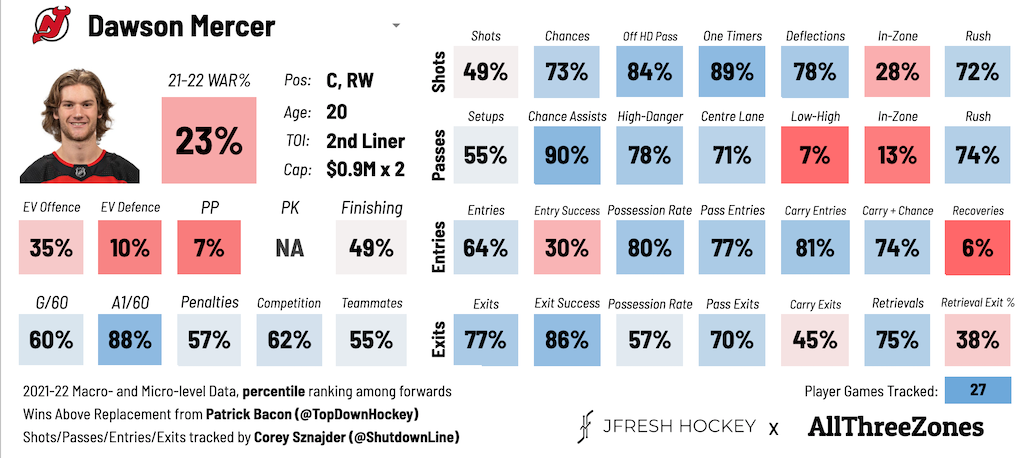Though the New Jersey Devils made some additions to their forward group this offseason by signing Ondrej Palát and trading for Erik Haula, they’ll still be relying on their young forwards to provide scoring for the 2022-23 season. There’s always some risk in that strategy. And as we’ve seen in the last couple of years, it hasn’t always worked out. With that said, there’s more reason to be optimistic about it producing better results this coming season.
Alexander Holtz may be ready for the NHL, but the player positioned for a bigger step forward is Dawson Mercer, who finished with 17 goals and 42 points while playing in all 82 games as a rookie. While his underlying numbers were a mixed bag, as should be the expectation for a 20-year-old rookie playing in the NHL, there’s plenty to suggest a jump in production is in store for Mercer in year two.
Mercer’s Solid Rookie Season
Along with Holtz, Mercer was one of three first-round picks the Devils used at the 2020 draft. Holtz was a top-10 selection and is the higher upside prospect. He had a strong season in the AHL last year as a 20-year-old and could be ready for the jump to the NHL. But as of now, Mercer is ahead in his development.
Mercer came out of the gate hot a year ago, totaling six goals and 14 points across his first 20 games. With Jack Hughes out with a dislocated shoulder until about American Thanksgiving, Mercer was operating as the team’s second-line center alongside Andreas Johnsson and Jesper Bratt, one of the best line combos the Devils used during the 2021-22 campaign.
But as is the case with just about any rookie, Mercer did cool off. After his first 20 games, he had only 11 points in his next 29 contests. The rookie wall, as they say, but Mercer did pick it up again when coach Lindy Ruff moved him to right wing alongside Hughes and Yegor Sharangovich in mid-February. He then spent most of his time at right wing until Hughes sprained his MCL in early April, which ended his season and put Mercer back at center.

Mercer finished with two points in his last 12 games at center after Hughes’ MCL sprain. But in those 20 or so contests at right wing with Hughes and Sharangovich, he finished with six goals and 15 points. The overall body of work for the season was solid, as he finished with an expected goals percentage (xG%) of 50.3 percent and averaged 1.71 points per 60 minutes at five-on-five. His impacts weren’t great at even strength, but it’s hard to complain about that for a 20-year-old rookie.
This might not tell you much about Mercer’s rookie season other than he was pretty productive, especially for someone who surprised and made the NHL as soon as he did. But when you dig deeper and look at his microstats, which Corey Sznajder (@shutdownline on Twitter) tracks manually, Mercer did plenty of things you want to see from not just a young player but any forward a team wants in their top-six.
Mercer’s Microstats Show Promise
This isn’t an apples-to-apples comparison since Hughes was the first overall pick in 2019 and Mercer went 18th overall in 2020, but Hughes’ impacts as a rookie during the 2019-20 season were also in the red. This past season, he produced at a 94-point pace in his third season, so there was clear progress.
Mercer isn’t going to turn into the next Hughes. But much of what Hughes excelled in as a rookie is what Mercer did well too. Using Sznajder’s microstats work, let’s look at Mercer’s shot, passing, and transition data, all of which tell a better picture of how he performed.
Mercer averaged just a bit under two shots on goal per game as a rookie. He wasn’t a high-volume shooter, but the rest of his shot data looks solid. He ranked above the 80th percentile in shots off high-danger passes and one-timers and just under the 80th percentile in deflections. His in-zone shooting wasn’t great, but he fared well shooting off the rush.

Mercer’s passing numbers look similar as well. He ranked in the 90th percentile in assists that led to scoring chances and above the 70th percentile in passes to high-danger areas and the center lane. Like his shooting ability, he was also a good passer off the rush. Mercer’s in-zone passing and shooting need to improve, but that will come in time as his game matures and he continues to get stronger.
When it comes to his transition game, Mercer is more than efficient. His zone-entry success rate isn’t great, but he attempts them with possession at a good clip, ranking in the 64th percentile. His possession, pass- and carry-entry rates look good, as does his ability to exit the defensive zone. So not only can Mercer enter the offensive zone with possession, but he also exits the defensive zone cleanly more often than not. Here’s a visual of Sznajder’s data, courtesy of JFresh Hockey, to help better demonstrate the stats just shared:

Microstats don’t always guarantee a jump in production, but they’re usually a good indication. And with Mercer, it appears that should be on the horizon. Once he matures physically and starts to add more in-zone offense to his game, the goals and points should come at a pretty consistent clip. His role this coming season could help him head in that direction as well.
Mercer Will Get an Opportunity in the Top-six
Based on general manager Tom Fitzgerald’s comments earlier this summer, Mercer will likely get a chance as a top-six winger to start 2022-23. Given his success in that role with Hughes and Sharangovich, it’s not surprising to see Fitzgerald say that. Though he started last season as a center, he’s the type of player the Devils will want in their top-six. That’ll be difficult as a center with Hughes and Nico Hischier as the team’s top two pivots for the foreseeable future, so the move to the wing makes sense.
If back with Sharangovich and Hughes to start next season, it’ll be interesting to see what they built on in the 201 minutes they played together at five-on-five in 2021-22:
- Corsi for percentage: 51.86 percent
- Scoring chances for percentage: 54.05 percent
- High-danger chances for percentage: 53.85 percent
- xG%: 49.23 percent
The Devils were outscored 16-14 with this trio on the ice, but that’s because the team’s goaltenders had a save percentage of only .872 when they were on the ice. That should change this season if the recently acquired Vitek Vanecek plays as he did with the Washington Capitals during his first two NHL seasons. Otherwise, there’s plenty to like about these three as a unit. Hughes is trending toward star status, Sharangovich is a plus-shooter, and Mercer can do a bit of everything and seems to have play-driving potential.
Related: Devils Need a Healthy Hamilton for the 2022-23 Season
If not with Hughes, then Mercer will likely get a chance alongside Hischier. He struggled quite a bit with Hischier in 2021-22; all the stats listed in the paragraph above were below 42 percent with Hischier. However, it was only in a 75-minute sample, and just because it didn’t work a season ago doesn’t mean it won’t work in 2022-23. The Devils will experiment with them together, perhaps with Palát rounding out the trio, which could make for a formidable second line.
It’s hard to quantify how much of a jump Mercer could make in year two. With that said, there’s a lot to like about what he did as a rookie. I don’t think breakout is the right word to describe what he could do, but his microstats suggest a noticeable step forward is possible. Plus, playing in the top-six alongside Hischier or Hughes should certainly help him. Is he going to become a 30-goal, 70-plus-point scorer in only his second season? Probably not, but 20-plus goals and 50-plus points with improved impacts is a reasonable expectation and seems achievable given what he did in just his first year in the NHL.
* * *
Advanced stats from Natural Stat Trick
